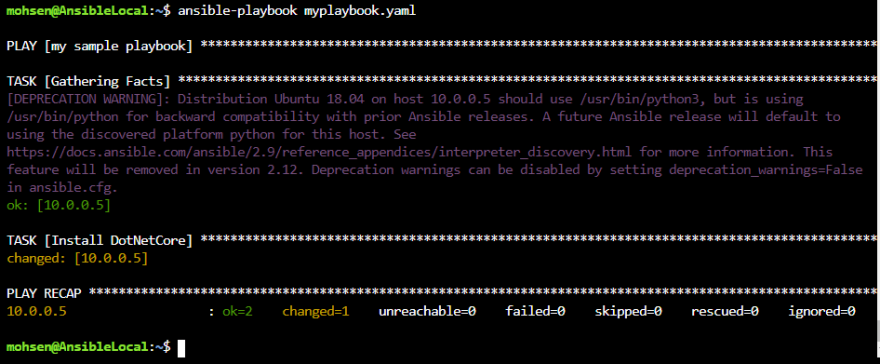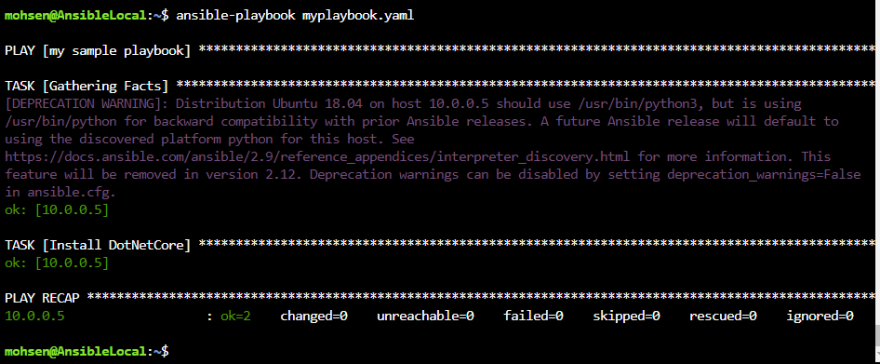Ansible
Ansible is an IT automation tool but I am going to use it here as a deployment tools. Ansible manages machines in an agent-less manner, so I only need to install it on my managing machine.
Provisioning 2 VMs
I have provisioned 2 Ubuntu VMs on Azure. The managing VM is called AnsibleLocal and the other one is called node01.
Installing Ansible on the AnsibleLocal machine
From Azure cloud shell ssh to the local machine and then run following commands:
$ sudo apt update
$ sudo apt install software-properties-common
$ sudo apt-add-repository --yes --update ppa:ansible/ansible
$ sudo apt install ansible
If you have different OS find the installation instruction from here
Per Microsoft recommendation we are going to use snap module. Then ensure the version of ansible is greater than 2.8.
ansible-playbook --version
again to see the details of this module you can try:
ansible-doc -t module snap
Adding the node01 machine
We need to tell ansible the machine(s) which are going to be managed. Edit the ansible hosts file.
nano /etc/ansible/hosts
Create a group and add the IP and ssh login details of the node machine(s)
[MyGroupA]
10.0.0.5 ansible_ssh_pass={a password} ansible_ssh_user={a user}
Creating the playbook
Create a yaml file
nano myplaybook.yaml
and put the following content:
- name: my sample playbook
hosts: [MyGroupA]
remote_user: mohsen
become: true
tasks:
- name: Install DotNetCore
snap:
name: dotnet-sdk
channel: 3.1
classic: yes
state: present
Note: the hosts group name (MyGroupA) and the remote_user is what we have defined in /etc/ansible/hosts file.
Note: The snap module parameters used here are coming from Microsoft instruction:
sudo snap install dotnet-sdk --channel=3.1/beta --classic
In this example we are installing the dotnetsdk but in real cases we might only need dotnet runtime so the snap properties would be like:
- name: Install DotNetCore
snap:
name: dotnet-runtime-31
state: present
In the most of ansible modules the property state accept following choices:
- present: it would install
- absent: it would uninstall
Before running the playbook you can do a syntax check on it:
ansible-playbook myplaybook.yaml --syntax-check
Running
Finally, you can run our playbook:
ansible-playbook myplaybook.yaml
The output would be like

If we run the playbook again, it would detect the DotNetCore is already installed so the changed would be 0 but the ok would be still 2.
The output this time would be like

Now, we are going to ssh to the node01 VM and do a test. Again, as explained by Microsoft:
When .NET Core is installed using the Snap package, the default .NET Core command is dotnet-sdk.dotnet, as opposed to just dotnet
Thus we would test as:
dotnet-sdk.dotnet --version







Latest comments (0)